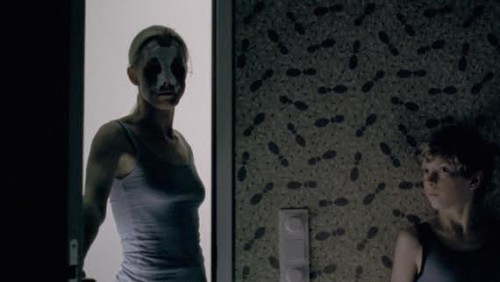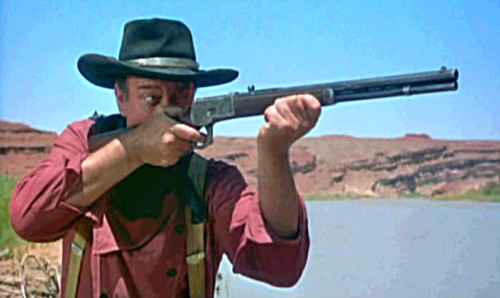This guest post by Claire Holland previously appeared at Razor Apple and is cross-posted with permission.
Be warned: This post is full of spoilers for Goodnight Mommy, Cub, and The Boy.
More often than not, horror movies reveal the fears of our time. In Axelle Carolyn’s excellent book, It Lives Again! Horror Movies in the New Millennium, the author illustrates how our collective fears end up reflected in different ways on screen. Carolyn makes the argument (and backs it up) that the popularity of every big horror trend originated somewhere in our collective consciousness, connecting trends to a country’s political climate, terrorist attacks, and other big events that resonant deeply throughout cultures.
As the late and great Wes Craven said, “Horror films don’t create fear. They release it.”
Carolyn’s book came to mind recently as I watched a crop of new films, each about the potential for violence in young boys: Goodnight Mommy, Cub, and The Boy. These films work to varying degrees, and the circumstances are diverse, but the core of each story is the same – one violent little boy. In a society where privileged young men (i.e. heterosexual, white, young adult males) are committing heinous crimes like date rape and mass shootings on an alarmingly regular basis, a fear of angry young men seems valid, and reason enough for a trend in horror.
Of course, these are horror movies, not case studies. As much as horror reflects society’s fears, it distorts them, making them ever more monstrous. In Goodnight Mommy, a young boy, Elias, suffers from a break with reality, imagining his dead twin brother is still alive and the woman living in his house is merely masquerading as his mother. In Cub, Boy Scout Sam stumbles onto the lair of Kai, a feral child living, and killing, out in the woods. The Boy takes the most realistic tack by far, examining the lonely childhood of a budding murderer, Ted, growing up in the middle of nowhere. These are the origin stories of the Angry Young Man, told through the lens of the horror genre.
There are numerous parallels between the three boys, who all engage in gradually escalating forms of violence: they kick chickens, kill dogs, and eventually wind up super gluing their mothers’ lips together or setting buildings full of people aflame. They’re all isolated: Elias’s brother and father are dead, his mother distant; Sam is a foster child without friends, a kid whom even the Boy Scout troop leader disdains; and Ted lives in a desolate motel with only his alcoholic father and a few passing guests for company. Most importantly, though, their attempts at connecting with others are constantly thwarted, or even actively discouraged.
When Elias, out of grief and guilt, insists that his mother speak to Lukas or make him breakfast, his mother reacts furiously, verbally and physically berating Elias. She slaps him and makes him to repeat aloud, “I will not speak to Lukas,” over and over again, when what Elias clearly needs is his mother’s love and understanding – and therapy. Bafflingly, Elias and his mother live in a lavish house that seems completely sequestered from the rest of the world, making the boy’s isolation all the more palpable. Given no one to talk to or work through his feelings with, Elias lashes out at the only person he can, creating an elaborate fantasy wherein his mother is an evil imposter who must be tortured until she can bring back his real mother and, presumably, the rest of his family.
In The Boy, Ted seems like a fairly normal kid, albeit one who is very comfortable with death. His father pays him pennies for picking up road kill, a pastime that eventually morphs into Ted luring animals onto the road. This is troubling, but the sort of behavior that might be curbed by an involved parent (preferably one who doesn’t demand road kill in exchange for attention). Under the nonexistent supervision of his father, however, Ted’s interest in death blooms, as does his inferiority complex – a dangerous combination. As with Elias, when Ted reaches out for companionship and acceptance – first to his father, and then to a kind but troubled drifter – he is beaten down, emotionally and physically. His pain and anger eventually culminate in murderous arson. This doesn’t seem like the story of a cold, calculating sociopath, no matter how much the filmmaker bills it that way. Ted is full of feelings, but because those feelings are never validated, he can only find destructive ways to express them.
Cub carries out this same model, but to cartoonish heights. Sam is the odd kid out in his Boy Scout troop, so when he encounters feral Kai on a camping trip in the woods, he feels an immediate kinship with the outcast and the two form a cautious rapport. At one point, the troop leader sics his dog on Sam as a mean joke, so Kai kidnaps the dog and hangs it from a tree so that Sam can kill it. Kai, a boy who has been used and abused by those bigger and stronger than him, considers this a gift. Sam is initially shocked and repulsed, but when he tries to help the dog and is bitten for his trouble, he retaliates, sick of being hurt by those he reaches out to again and again. Unable to truly forge a bond with anyone, Sam finally kills Kai so that he can take over the feral boy’s malevolent, vengeful persona.
The shared element in these three stories of angry young men is an unwillingness of the guardians and role models to nurture, or even condone, sensitivity in these boys. They constantly demand that the boys be tougher, thicker-skinned, less vulnerable, regardless of their actual feelings or needs. When Ted’s father allows a prom afterparty to take place at the motel, sans parents, he tells Ted, “The boys’ll be boys and the girls’ll be girls; good, harmless fun. You get what I’m sayin’?” One can easily imagine the kind of behavior Ted’s father is allowing, and tacitly condoning. “Boys will be boys” encompasses all manner of sins. When those same boys hurt Ted and his father blames him, Ted sees no other option than to become a stronger (read: hyper-masculine) version of those cruel boys in order to survive.
We can’t excuse violent criminals for their actions just because they may have had bad childhoods, but our society’s emphasis on the masculine above everything else is a real problem. Forcing young boys to “toughen up” before they’re ready only forces them to give up their empathy, and that benefits no one. These three stories are horrific, but they are, after all, just stories. Unfortunately, the real crimes committed by angry young men – Sandy Hook, Steubenville, Aurora – are as gruesome as fiction.
Claire Holland is a freelance writer and author of Razor Apple, a blog devoted to horror movies and horror culture with a feminist bent. Claire has a BA in English and creative writing, but she insists on writing about “trashy” genre movies nonetheless. You can follow her on twitter @ClaireCWrites.


















